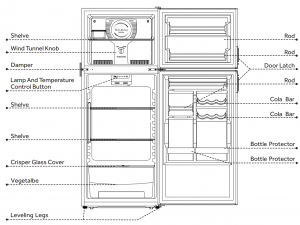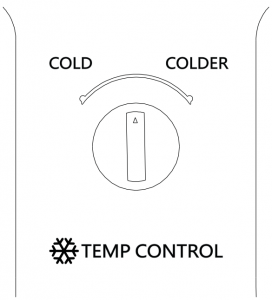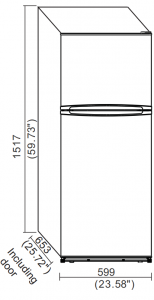EVER CHILL Top Mount Refrigerator

To ensure proper use of the appliance and your safety, please read the following instructions completely before operating this appliance.
Usage note
Do not remove the back panel during installation.
- In order for normal use, the connection must be reliable. Besides the power source proper connection, the wire of the unit and outer wire must meet the following requirement:
Wire size The max length (Feet) 14AWG 3.2 Feet 13AWG 8 Feet 12AWG 13Feet 10 AWG 20 Feet 8AWG 33 Feet 6AWG 50 Feet Remarks: 14 AWG wire is not recommended. 13 AWG wire or Larger is recommended. This DC unit is not equipped with a power source. Please purchase a power source from an authorized dealer. - When using an adaptor or converter AC to DC, No DC power supply is recommended. The operation of the DC refrigerator is also dependent on a good, clean ground connections.
- It is recommended that only authorized or qualified professionals perform repair services on unit.
Wire connection diagram

- Connect ➀ terminal with Positive pole of 12V DC.
- Connect ➁ terminal with Negative pole of 12V DC.
- If the unit is installed in an RV, The ➂ GND terminal should be connected to a metal portion of the RV.
FEATURES AND PARTS

- Shelf block and door latch(disassembly is not allowed in daily use).
Important Safety Instructions
 To reduce the risk of fire, electrical electrical electrical shock, or injury follow these basic precautions precautions precautions when using your refrigerator.
To reduce the risk of fire, electrical electrical electrical shock, or injury follow these basic precautions precautions precautions when using your refrigerator.
- DANGER: Risk of child entrapment. To avoid the possibility of child entrapment, please take the following precautions before you dispose of your
- Remove all
- Leave shelves in place so children may not easily climb
- Never allow children to play with, operate, or crawl inside the
- Do not store or use gasoline or any flammable vapors and liquids in the vicinity of this
- All refrigeration products contain refrigerants, which under the guidelines of federal law must be removed before It is the consumer’s responsibility to comply with federal and local regulations when disposing of this product.
- This appliance is not intended for use by persons (including children) with reduced physical, sensory or mental capabilities, or lack of experience and knowledge, unless they have been given supervision or instruction concerning use of the appliance by a person responsible for their
- Children should be supervised to ensure that they do not play with the
Installation Instructions
Before Using Your Refrigerator
- Remove the exterior and interior
- Before connecting the refrigerator to the power source, let it stand upright for approximately 4 hours. This will reduce the possibility of a malfunction in the cooling system from improper handling during
- Clean the interior surface with lukewarm water using a soft (Cleaning instructions down below)
Location
- This appliance is designed to be free standing
- Allow 1 inches clearance space between the back and sides of the refrigerator, which allows the proper airAvoid Installation:
- On weak surfaces unable to support refrigerator when fully
- In direct sunlight and sources of heat (stove, heater, radiator, etc.) will hinder the performances of this appliance
Installing Your Refrigerator
- Adjust the leveling feet to keep the refrigerator level.
Electrical Connection


This refrigerator should be properly grounded for your safety.
This refrigerator requires a standard 9-17V , electricity >15A. Direct connection with AC power source is forbidden.
Do not connect this unit to an AC power source.
To prevent accidental injury, the electrical cord should be secured behind the refrigerator, and not be left exposed or dangling.
Operating Your Refrigerator
Temperature control
The temperature of refrigerator can be controlled manually by the display However, the number shown on the display does not directly represent the temperature. Instead, the larger the number is the lower the interior temperature will be. Initially set the refrigerator control on the middle setting(number 3).If you want to set the refrigerator temperature to a colder temperature pressing the set button until the state on 4 or 5. Each time the set button is pressed, the state increases by 1. When the state is in the highest state, press the button again and return to the first state.
Power ON/OFF
To turn on and off the fridge:To press the “SET” button in the freezing room for 10 seconds, the fridge will be at Standby mode; The power LED “SET” will be flashing, To press “SET” button again for 10 seconds to turn the fridge on, and power LED light will be on.

Freezer Compartment Operation
Temperature Control
If the refrigerator’s lower temperature is needed, please regulate the konb along the “COLDER” direction; contrarily, regulate the konb along the ”COLD” direction.

| NOTEDo not store canned foods or food stored in glass containers in the freezer compartment. |
The Freezer Compartment
This compartment is designed for the long-term storage of frozen food. The storage life of frozen foods varies and the recommended storage time should not be exceeded.Place frozen food into the freezer as quickly as possible after purchase. If there are instructions on the packet, carefully follow these instructions regarding storage times.
Care and Maintenance
Cleaning Your Refrigerator
- Clean interior and parts with a cloth soaked in lukewarm water and baking soda solution. A solution of 2 tablespoons baking soda to a quart of water will clean and neutralize odors. Rinse and wipe dry.
- Be sure to keep the door gasket (seal) clean to keep the unit running efficiently.
- The outside of the refrigerator should be cleaned with a warm damp cloth and mild detergent. Do not use harsh or abrasive cleaners.
- Never clean refrigerator parts with flammable fluids. The fumes can create a fire hazard.
Vacation Vacation
- For long vacations, remove all food.
- Clean the interior and leave doors open to avoid possible odor or mold formation.
- Use extreme caution in the case of children. The unit should not be accessible to child’s play.
Moving Your Refrigerator
- Disconnect the power source.
- Remove all the food and securely tape down all loose items such as shelves, drawers, and doors.
- Be sure the refrigerator stays in the upright position during transportation.
Energy Saving Tips
- The refrigerator should be located in the coolest area of the room, away from heat producing appliances or heating ducts, and out of the direct sunlight.
- Let hot foods cool to room temperature before placing in the refrigerator.
- Be sure to wrap foods properly, and wipe containers dry before placing them in the refrigerator. This cuts down on frost build-up inside the refrigerator.
- Organize and label food to reduce door openings and extended searches
Installation
Install the refrigerator in a convenient location away from extreme heat and cold. Allow sufficient clearance between the refrigerator and side wall so the door(s) will open without obstruction. Refrigerator is not designed for recessed installation.Select a space with strong level floor.Allow 1 inches of space between the refrigerator’s side and the wall.The appliance must be correctly connected to the power supply.



- Note: The door should protrude at least 1” beyond the surrounding cabinets.
Troubleshooting Guide
You can solve many common refrigerator problems easily, saving you the cost of a possible service call. Try the suggestions below to see if you can solve the problem before calling for service.
| Problem | Possible Causes |
| Refrigerator does not operate |
|
| Compressor turns on and off |
|
| Refrigerator compartments are too warm |
|
| Vibrating or rattling (slight vibration is normal) |
|
| Temperature of external refrigerator surface is warm |
|
| Moisture collects inside the refrigerator |
|
| Moisture forms on outside of refrigerator |
|
| Bubbling or gurgling sounds (like boiling water) |
|
| Popping or cracking sounds when compressor comes on |
|
| The door will not close properly |
|


[xyz-ips snippet=”download-snippet”]

